Memorial Day is behind us now. Summer is “unofficially” in swing. Here are 8 quick summer landscaping tips to keep your outdoor space looking great!
1. Be on the lookout for turf problems
The beginning of summer means the beginning of “turf disease season!” High humidity paired with relatively warm overnight temperatures turns your lawn into a petri dish for a whole host of fungi. They all require the fungal spores to be present, along with a host (the grass) and the right growing conditions (like those described above). A couple of common turf diseases to look for include:
Red Thread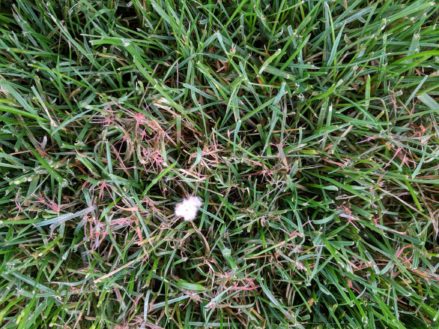
This disease looks pretty awful, but it’s really pretty harmless. It almost looks like cotton candy is caught on the blades of the grass. A fertilizer application will help the turf push new growth and will cause the grass to “outgrow” the progression of the disease. Additional treatment is usually not necessary.
Pythium Blight
Pythium blight really shows up in our area once our summer temperatures hit. High heat helps this fungus breed, along with an extended period of “wetness” on the turf. Treatment is absolutely necessary – your lawn will likely die without it. This disease spreads quickly, and even if you call your lawn care pro, the turf may be dead by the time they get there to treat anyway. Don’t play around with this exceptionally quick-spreading disease!
Brown Patch
According to Turf Magazine, brown patch is the most common disease distressing Kentucky bluegrass, tall fescue, and perennial rye – which is mostly what’s in our lawns in Central Pennsylvania. This disease usually requires corrective treatments once it’s shown up on a lawn. If you know you have a history of it, you should start preventive treatments in late May as a general rule.
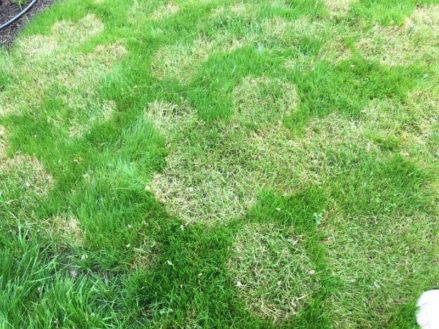 Dollar Spot
Dollar Spot
Named for the “silver dollar” shaped rings it leaves on the turf as it grows. Dollar spot is unsightly and certainly puts an added level of stress on the turf. However, in our area, only advanced stages of the disease should be treated. Usually, a good fertilizer application will help the turf push new growth, preventing the disease from doing much damage.
2. Raise the lawn mower/mow less frequently
We often get the phone calls in the summer from clients who are concerned their lawn is “dead.” We appreciate those calls, because it gives us a chance to inspect for the diseases mentioned above.
Often times it is simply a case of heat and/or drought stress. This is actually a pretty natural part of the turf’s lifecycle. In our area, cool-season grasses are the norm. These types of grass grow really well in Spring and Fall, when temperatures are cooler. They don’t like hot, dry weather, like we typically experience in July and August.
As a result, the lawn enters a period of dormancy as a defense mechanism. Think of it like a bear hibernating for the winter because food is scarce. Same with the grass – moisture is less available, so it’s just riding out the hot, dry spell. The grass quits investing so much energy into vertical and root growth and begins to store nutrients and moisture in the leaf tissue (grass blades) to wait until conditions improve.
What you should do
What all this means for you as the homeowner is two things. First, raise the height of the mower. If you mow longer, you leave more moisture in the plant itself, making it more resilient to heat and drought stress. You never want to mow off more than 1/3 of the leaf blade in a single mowing, as this can cause stress to the plant. Also, make sure you’re leaving the grass long. Turf should be no lower than three inches after mowing is complete.
Secondly, you can mow less frequently. If the grass isn’t growing as quickly, you don’t need to mow. Start adjusting your mowing habits to reflect the growth of the lawn rather than being wed to a calendar day (like mowing every Saturday). You may only have to mow every two-to-three weeks during this time.
3. Apply grub control to the lawn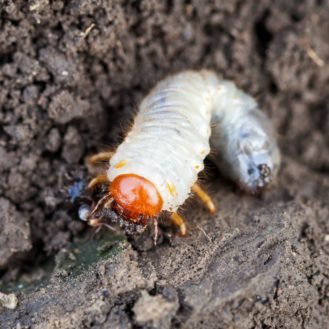
There are at least half a dozen species of beetle in our area that lay eggs in the soil that damage turf. While the May-June beetle, green June beetle, and European chafer may not get a lot of press, their larvae (grubs) can be just as destructive as their more famous cousins, the Japanese beetle.
These beetles feed on landscape plants, mate, and lay eggs in the soil. When those eggs hatch, the larvae reach their next stage in maturity by feeding on the roots of your lawn. When they’re present in high numbers, they can do significant damage to the lawn by eating the grass roots up to the soil surface, which obviously kills the grass plants.
What you should do
Applying a grub control to the lawn in the summer (many people use the July 4th holiday as a reminder) will help protect your lawn against damage. These products can be found in your local home center or hardware store and come from a variety of manufacturers. Keep in mind that these applications typically need to be “watered-in,” so plan it around rain showers or get out the sprinkler for the best results.
4. Trim some shrubs
There are some shrubs that you really should consider trimming in the summer. These include lilac, forsythia, azaleas, rhododendrons, and some species viburnum. Basically, if it blooms once a year and is done blooming now, trim it. The reason is pretty simple: they’ve bloomed now.
What you should do
Trimming these plants after they’ve bloomed ensures you’ll still get to look at the beautiful flowers. It also means that they have plenty of time to push new growth before next year. Lastly, it ensures that you won’t interfere with next season’s blooms!
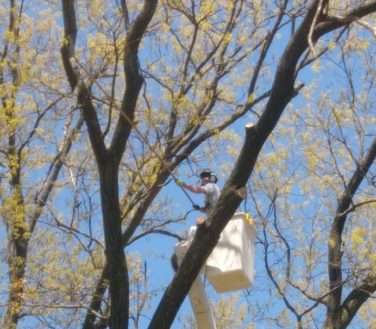 5. Get trees pruned
5. Get trees pruned
Many folks assume that it’s a spring or fall task to have your trees pruned. They’re wrong. You can prune most trees year-round.
This is a service you can do yourself, but we generally recommend against that. Improper pruning can lead to problems that make the tree sick or vulnerable to pests. This can kill the tree down the road.
Tree pruning is also a pretty dangerous enterprise. According to the Bureau of Labor Statistics, in 2016 there were 166 incidents where a full-time worker was injured primarily by “Plants, trees, or vegetation – unprocessed.” Their spreadsheet (click on “Primary and secondary source of injury by major private industry division, 2016” to open the spreadsheet) indicates that 146 of those incidents were related to “Trees, logs, limbs – unattached.” Translation: pruning and trimming trees is highly dangerous, even if you’re a professional.
What you should do
Safety first! Contact a knowledgeable professional with a good reputation, because their backlogs often run several weeks. It’s a good idea to bank on that and plan your job well in advance.
As an added bonus, if it’s hot and dry outside the ground is likely firmer. A firmer soil means fewer ruts in the lawn if they need to drive equipment (like a bucket truck) across it.
6. Edging and mulching
Yes, you read that correctly. Most people assume this is an “all or nothing” proposition in the Spring.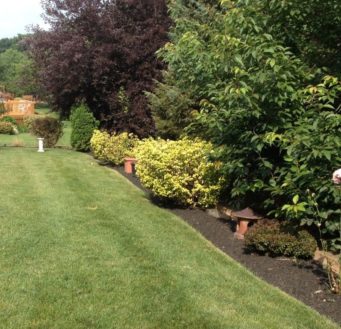
The truth of the matter is that this can be done throughout the year. We even have several clients that get their edging and mulching for the season done in Fall. (When the snow melts, they usually just have to blow the leaves out of the beds and they’re done with Spring cleanup!)
What you should do
Mulching serves two main purposes on your landscape. The first is that it holds in moisture that the plants get and keeps the root system healthy. When we do get some rain, the mulch prevents that water from evaporating immediately, and allows it to soak into the ground. When it’s hot and dry, and moisture is scarce, you want your plants to have something to hold that moisture in.
The second purpose of mulching is to keep weeds down. Many weeds will grow far more rapidly and in much worse conditions than your landscape plants. Giving them every chance to compete is just common sense, right?
Edging the beds helps hold the mulch in place. Plus, it gives you the added bonus of distinction between your lawn spaces and bed spaces, for a clean, manicured look.
7. Apply pre-emergent weed control to the beds
You can actually apply products to your flower beds that prevent weeds from growing. These are called “pre-emergent” herbicides, because they are applied before the weeds emerge. There’s a direct comparison to your lawn care – crabgrass control early in the Spring is a pre-emergent herbicide.
What you should do
Depending on the product you decide to use, you should apply your first or second treatment of pre-emergence. If you’re using an “over-the-counter” product like Preen, you want to re-apply mid-season to keep weeds down throughout the year.
However, there are many options for these types of products. If you’re hiring a professional, they may be able to use other products like Barricade (prodiamine) or Dimension (dithiopyr) to give you an extended period of control for weeds.
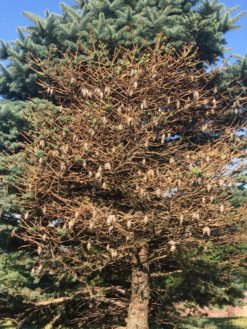 8. Inspect your landscape for potential problems
8. Inspect your landscape for potential problems
Familiarity with your landscape is important here. Different species of plants get different problems at different times of year. Knowing what trees and shrubs you have in the landscape is the first step toward keeping those plants healthy.
For example, if you have pets, you wouldn’t feed your dog and your cat the same thing. You also (hopefully) don’t use the same medication on them to control fleas and ticks. The same principle applies as a parent – there are some things you have that are hard-and-fast rules for all the kids. But, you undoubtedly allow for differences in age, maturity level, and personality on the “negotiable” items.
What you should do
It is very similar for your trees and shrubs. If you shouldn’t treat your boxwoods for pest activity at the same time of year you treat your arborvitae. They are susceptible to different pests, and need treated for those pests at different times of year.
Look carefully at anything that doesn’t look “right” with the plants – spots on leaves, curling or cupping of leaves, holes in leaf tissue, browning of needles, needles dropping in the summer – you get the idea. If it doesn’t look healthy, it’s probably not. Figure out what plant it is and do a quick internet search for “problems with plants” to find out what issues are common to them. Another search string might be “What’s wrong with my tree?” for a fast result.
Knowing which plants you’re treating, and what to do about the issues, is key.
If you have questions, we’d love to talk with you about summer landscaping tips at your property. Contact us for your free consultation.

